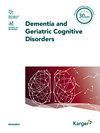Timed Up and Go in People with Subjective Cognitive Decline Is Associated with Faster Cognitive Deterioration and Cortical Thickness
IF 2.2
4区 医学
Q3 CLINICAL NEUROLOGY
引用次数: 4
Abstract
Introduction: Early markers of neurodegeneration provide an opportunity to detect, monitor, and initiate interventions in individuals who have an increased risk of developing dementia. Here, we investigated whether the Timed Up and Go (TUG) test is associated with early brain neurodegeneration and whether the TUG test could be a marker of cognitive decline in people with subjective cognitive decline (SCD). Methods: This is a longitudinal analysis of the Dementia Disease Initiation Study, a prospective, community-based, cohort study from Norway, designed to investigate early markers of cognitive impairment and dementia. Participants were classified as SCD and healthy controls (HC). The main studied variables were the TUG test and cognition as measured by the Mini-Mental State Examination and the Consortium to Establish a Registry for Alzheimer’s Disease memory composite score. Additionally, we investigated the cross-sectional association of brain morphology with the TUG using 1.5T-MRI. Results: The sample included 45 participants (SCD = 21, HC = 24) followed during a mean time of 1.50 ± 0.70 years. At baseline, the cognitive performance did not differ between the groups, but TUG was longer in SCD. Slower baseline TUG was associated with a faster cognitive decline in both groups and it was also associated with reduced cortical thickness especially in motor, executive, associative, and somatosensory cortical regions in people with SCD. Discussion/Conclusion: TUG predicted cognitive change in individuals with SCD, and there was a negative association between TUG and cortical thickness. TUG is a promising cheap and noninvasive marker of early cognitive decline and may help initiate interventions in individuals who have an increased risk of dementia.主观认知能力下降的人与更快的认知退化和皮层厚度有关
引言:神经退行性变的早期标志物为检测、监测和开始干预痴呆风险增加的个体提供了机会。在这里,我们研究了定时上下运动(TUG)测试是否与早期大脑神经退行性变有关,以及TUG测试是否可以作为主观认知能力下降(SCD)患者认知能力下降的标志。方法:这是对痴呆症发病研究的纵向分析,这是一项来自挪威的前瞻性、基于社区的队列研究,旨在调查认知障碍和痴呆症的早期标志物。参与者被分为SCD和健康对照组(HC)。主要研究变量是TUG测试和认知,通过迷你精神状态检查和阿尔茨海默病记忆综合评分注册联合会进行测量。此外,我们使用1.5T-MRI研究了大脑形态与TUG的横断面关联。结果:样本包括45名参与者(SCD=21,HC=24),平均随访时间为1.50±0.70年。在基线时,两组之间的认知表现没有差异,但SCD的TUG更长。在两组中,基线TUG较慢与认知能力下降较快有关,也与皮层厚度减少有关,尤其是在SCD患者的运动、执行、联想和体感皮层区域。讨论/结论:TUG可预测SCD患者的认知变化,TUG与皮质厚度呈负相关。TUG是一种很有前途的廉价、无创的早期认知能力下降标志物,可能有助于对痴呆风险增加的个体进行干预。
本文章由计算机程序翻译,如有差异,请以英文原文为准。
求助全文
约1分钟内获得全文
求助全文
来源期刊
CiteScore
4.70
自引率
0.00%
发文量
46
审稿时长
2 months
期刊介绍:
As a unique forum devoted exclusively to the study of cognitive dysfunction, ''Dementia and Geriatric Cognitive Disorders'' concentrates on Alzheimer’s and Parkinson’s disease, Huntington’s chorea and other neurodegenerative diseases. The journal draws from diverse related research disciplines such as psychogeriatrics, neuropsychology, clinical neurology, morphology, physiology, genetic molecular biology, pathology, biochemistry, immunology, pharmacology and pharmaceutics. Strong emphasis is placed on the publication of research findings from animal studies which are complemented by clinical and therapeutic experience to give an overall appreciation of the field.

 求助内容:
求助内容: 应助结果提醒方式:
应助结果提醒方式:


